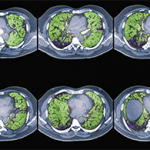Treatment decisions may be complicated further by comorbidities like pulmonary hypertension, a condition that can lead to heart failure, said Stephen Mathai, MD, assistant professor of medicine at the Johns Hopkins University School of Medicine in Baltimore. Pulmonary hypertension commonly complicates connective tissue–associated ILD, he said. The condition is related to multiple etiologies and must be assessed and treated on a case-by-case basis.
Incidence of pulmonary hypertension in ILD is difficult to assess, but some tests provide clues. Systemic sclerosis-ILD-PH is defined with a right ventricular systolic pressure (RVSP) measurement greater than 35 mm Hg. In patients with RA-ILD-PH, the RVSP is greater than 30 mm Hg. In both sets of patients, it is important to look at both pulmonary function and imaging results, Dr. Mathai said. However, an estimate of RVSP is only possible in 54% of patients with ILD, he added. Other tests to help diagnose pulmonary hypertension include echocardiogram, diffusing capacity (DLCO), and FVC/DLCO.
“Pulmonary hypertension is a bad prognostic indicator in many pulmonary conditions, and ILD is no exception,” said Dr. Mathai. Comorbidities need to be addressed in these patients, including heart failure with preserved ejection fraction, pulmonary embolism, and coronary artery disease, which is common. Obstructive sleep apnea may be seen, prompting treatment with an end-tidal or transcutaneous carbon dioxide monitor. Atrial arrhythmias are very poorly tolerated in pulmonary hypertension patients, he said.
Goals of treatment include improving functional capacity and quality of life as well as survival, Dr. Mathai said. If there is a reduction of oxygen content in the alveoli, constriction may lead to a worsening of oxygenation, he added. Current therapies include vasodilators, including oxygen therapy for patients with chronic hypoxemia; diuretics for patients with volume overload; and digoxin for patients who need to increase cardiac output.
Susan Bernstein is a freelance medical journalist based in Atlanta.

